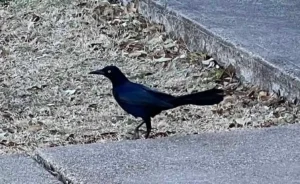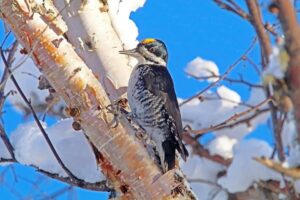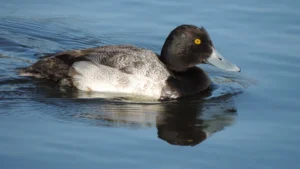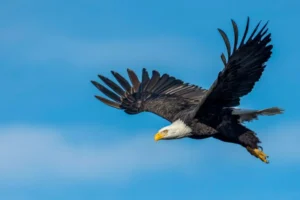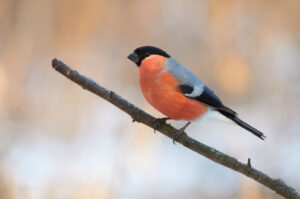Do you ever find yourself wondering about those black birds you see flying around your neighborhood? You know the ones—they’re sleek and mysterious, with their dark feathers and piercing eyes. Crow vs Grackle: Explore the differences between crows and grackles, two intelligent and often misunderstood bird species.
Well, get ready to uncover the secrets of the crow and the grackle. In this article, we will dive deep into the world of these black birds and explore their physical characteristics, habitat preferences, feeding behavior, vocalizations, and more.
By the end of this read, you’ll be able to easily distinguish between a crow and a grackle, and you’ll have a newfound appreciation for these fascinating creatures. So, get ready to spread your wings and embark on a journey of discovery.
It’s time to unlock the mysteries of the crow and the grackle.
Key Takeaways
- Crows have glossy black plumage, robust bodies, stout beaks, and fan-shaped tails, while grackles have a medium-sized, slender build and predominantly black coloration with iridescent blue or purple feathers on their heads and backs.
- Crows are adaptable to urban and rural environments, while grackles prefer open spaces with trees and shrubs.
- Crows have a diverse diet, including fruits, insects, small mammals, eggs, and carrion, while grackles are primarily insectivorous but also feed on seeds, berries, and small fruits.
- Crows have a wide range of vocalizations, from low and gruff to high-pitched and piercing, while grackles have distinctive calls and chirping sounds.
Physical Characteristics of Crows
Crows possess a sleek and glossy black plumage that distinguishes them from other species of birds. Their feathers have a shiny appearance, reflecting the sunlight and giving them a unique charm. With their strong and sturdy bodies, they are about 17 to 21 inches long and have a wingspan of around three feet. Crows also have a distinctive fan-shaped tail that helps them maneuver through the air effortlessly.
One of the most striking features of crows is their sharp and intelligent eyes. Their dark brown to black eyes are highly perceptive, allowing them to spot potential food sources or predators from great distances. Their beak is strong and slightly curved, enabling them to crack open nuts or scavenge for insects and small animals.
Crows are known for their loud and raucous calls. Their cawing sounds can be heard from a considerable distance, and they use different vocalizations to communicate with other crows. Their calls can range from low and gruff to high-pitched and piercing, depending on the situation.
In addition to their physical characteristics, crows are highly adaptable birds. They are found in various habitats, including forests, fields, and urban areas. Their ability to thrive in different environments has contributed to their widespread distribution across the world.
Physical Characteristics of Grackles
Grackles are medium-sized birds with a sleek and slender build. Their bodies are longer and more streamlined compared to crows.
Their coloration is predominantly black, with iridescent blue or purple feathers on their heads and backs. Their plumage is glossy and shiny, adding to their striking appearance.
Size and Shape
When it comes to size and shape, it’s fascinating to explore the differences between crows and grackles.
- Crows are larger birds, measuring about 17 to 21 inches in length, while grackles are smaller, ranging from 11 to 13 inches.
In terms of weight, crows are heavier, weighing around 12 to 21 ounces, whereas grackles are lighter, weighing approximately 3 to 5 ounces.
The shape of these birds also differs. Crows have a more robust and solid build, with a sturdy beak and broad wings. On the other hand, grackles have a sleeker and slender body, a longer tail and a slender beak.
Understanding the size and shape differences between crows and grackles can help us identify and appreciate the unique characteristics of each bird.
Coloration and Plumage
The mesmerizing coloration and plumage of these fascinating birds are truly captivating. The crow, with its glossy black feathers, has a sleek and shiny appearance. Its plumage is consistent in color throughout its body, giving it a uniform look.
On the other hand, the grackle has iridescent feathers that shimmer in various shades of blue, green, and purple when exposed to sunlight. This iridescence adds a beautiful and eye-catching element to the grackle’s appearance.
While both birds have black feathers, the grackle’s unique coloration sets it apart from the crow. The contrast between the crow’s glossy black and the grackle’s iridescent hues showcases the diversity of coloration and plumage found in the avian world.
Habitat Preferences
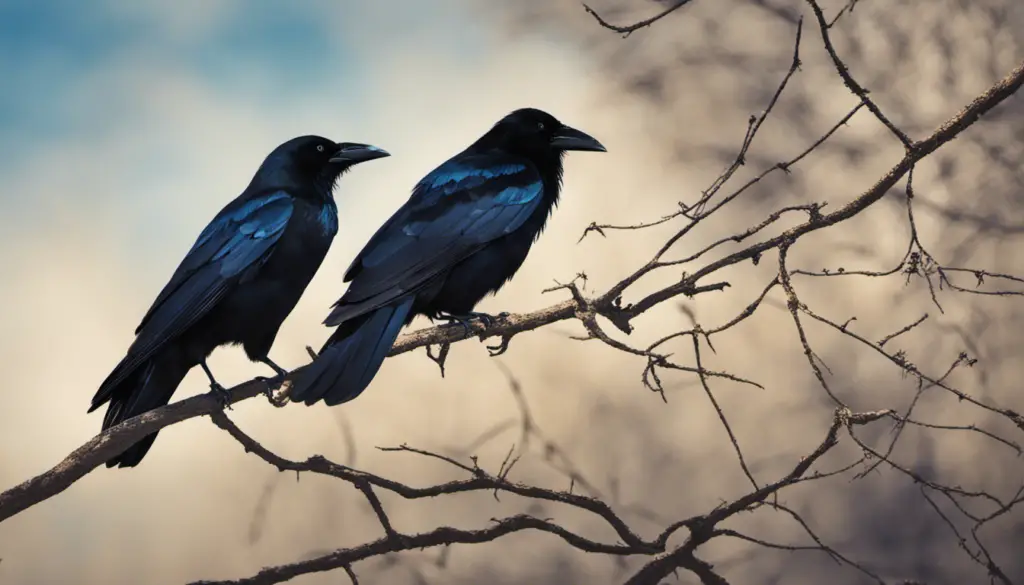
Imagine living in a neighborhood filled with beautiful trees and lush gardens where you could easily spot a crow or a grackle nesting among the branches. These two black birds may look similar at first glance, but they have distinct preferences when it comes to their habitats.
- Urban Areas: Crows are highly adaptable and can be found in both urban and rural environments. They are commonly seen perching on telephone wires or scavenging for food in city parks. Grackles, on the other hand, prefer open spaces with trees and shrubs, such as meadows or agricultural fields.
- Woodlands: Crows are often seen in wooded areas, building their nests high up in the trees. They are known to form large communal roosts during the winter months. Grackles, however, prefer more open woodlands and are often found near bodies of water like lakes or rivers.
- Suburban Gardens: Crows are adaptable enough to make their homes in suburban areas, where they can find food sources like garbage bins or bird feeders. Grackles, on the other hand, are less likely to be found in suburban gardens as they prefer more natural habitats.
- Migration Patterns: While crows are generally non-migratory, grackles are known to migrate seasonally. They can travel long distances to find suitable breeding grounds and food sources.
Understanding these habitat preferences can help you identify whether the black bird you see perched in your neighborhood is a crow or a grackle. So next time you spot one, take a closer look and see if you can determine which species it belongs to based on its surroundings.
Feeding Behavior
Feeding behavior for these black birds can vary depending on their habitat preferences. While both crows and grackles are opportunistic feeders, they have slightly different preferences when it comes to their meals.
Crows are known to be omnivorous, meaning they eat a wide range of foods. They have a diverse diet that includes fruits, insects, small mammals, eggs, and even carrion. Crows are also intelligent birds and have been observed using tools to extract food from hard-to-reach places. They are often seen foraging on the ground or in trees, searching for anything edible.
On the other hand, grackles have a more specialized feeding behavior. They are primarily insectivorous, meaning their diet consists mainly of insects. Grackles have long, slender bills that they use to probe the soil or grass for insects and larvae. They are also known to feed on seeds, berries, and small fruits. Unlike crows, grackles are more social feeders and can be found in large groups, especially during migration.
Understanding the differences in feeding behavior between crows and grackles can help us appreciate their unique ecological roles. Whether they are scavenging for carrion or hunting for insects, these black birds play an important part in maintaining the balance of their respective habitats.
Vocalizations and Calls
Now that you understand their feeding behavior, let’s dive into the vocalizations and calls of crows and grackles.
When it comes to vocalizations, crows and grackles are quite different.
Crows have a wide range of calls, from their famous ‘caw-caw’ to softer cooing sounds. They use these calls to communicate with other crows, establish territory, and warn of potential dangers. Their calls can be loud and raucous, echoing through the trees and captivating your attention.
On the other hand, grackles have a more distinctive call. Their vocalization is a unique mix of whistles, chatters, and raspy sounds. It’s a melody that’s hard to miss and impossible to ignore. Grackles use these calls to attract mates, communicate within their flock, and defend their territory.
Listening to the vocalizations of crows and grackles is like attending a concert where each bird has its own instrument. It’s a mesmerizing experience that evokes a range of emotions. From the eerie beauty of a crow’s call to the lively chorus of grackles, these black birds never fail to leave you in awe.
So, sit back, relax, and let the enchanting sounds of crows and grackles transport you to a world of avian melodies. Markdown list below will evoke an emotional response:
- The haunting call of a crow pierces through the silence, sending shivers down your spine.
- The melodious chatter of grackles fills the air, creating a sense of harmony and unity.
- The combination of these unique vocalizations creates a symphony of nature, leaving you feeling connected to the world around you.
Nesting and Reproduction
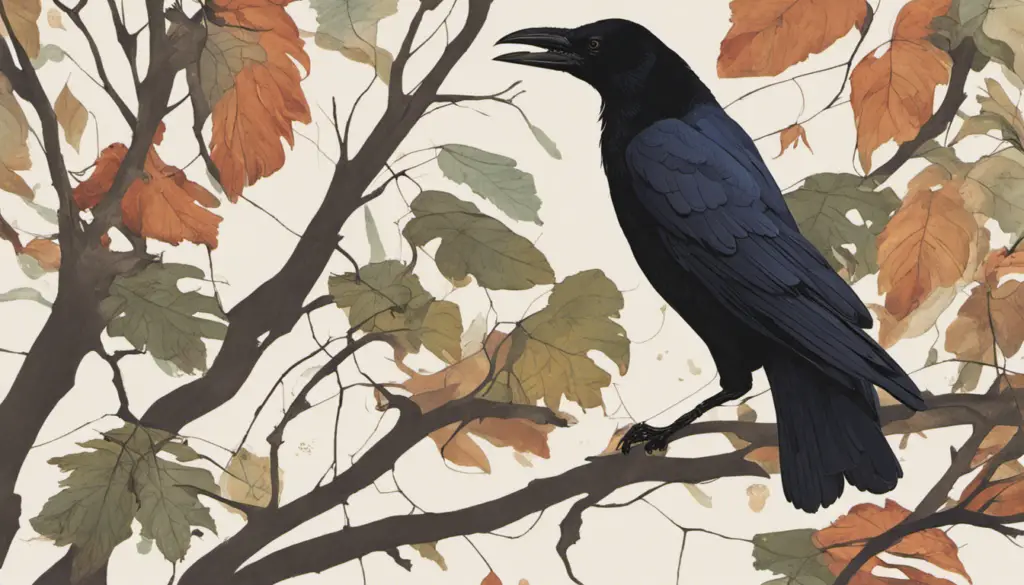
As we delve into the nesting and reproduction habits of crows and grackles, it’s fascinating to learn how these black birds build their intricate nests. Both crows and grackles are resourceful when it comes to constructing their homes, using materials like twigs, grass, leaves, and even bits of trash. Crows typically build their nests high up in trees, while grackles prefer dense vegetation or man-made structures like buildings or bridges.
When it comes to reproduction, crows and grackles have some differences. Crows are monogamous birds, mating with one partner for life. They form strong pair bonds and work together to raise their children. Grackles, on the other hand, are not as monogamous, often engaging in polygyny, where one male mates with multiple females. This can result in a complex social structure within grackle colonies.
Both crows and grackles are dedicated parents, fiercely protecting their nests and young from predators. They dive-bomb and mob potential threats to defend their offspring. Witnessing their dedication and commitment to their families is truly remarkable.
So, next time you see a crow or grackle perched on a tree or hear their distinctive calls, take a moment to appreciate the extraordinary efforts they put into building their nests and raising their young.
Social Behavior and Interactions
Get ready to be amazed by the fascinating social behavior and interactions of these intelligent black birds! Both crows and grackles are highly social creatures, forming large flocks that can consist of hundreds or even thousands of individuals. These flocks are not only made up of members of the same species but can also include other bird species as well.
One interesting aspect of their social behavior is their ability to communicate with each other using a wide range of vocalizations. Crows and grackles have a complex language that allows them to convey different messages and warnings to their flock members. They can also mimic the sounds of other birds and even human voices, showcasing their impressive vocal abilities.
Another intriguing behavior is their communal roosting. These birds gather together in large numbers to sleep and rest. The sight of hundreds of crows or grackles flying in synchronized patterns to their communal roosts is truly a spectacle to behold.
Social interactions within these flocks are also quite diverse. They engage in activities such as foraging together, mobbing predators, and even playing games. They establish hierarchies within the flock, with dominant individuals having priority access to food and nesting sites.
In conclusion, the social behavior and interactions of crows and grackles are truly remarkable. Their ability to communicate, roost together, and engage in various social activities showcases their intelligence and adaptability. Observing these black birds in their natural habitats is a truly awe-inspiring experience.
Migration Patterns
Prepare to be swept away by the mesmerizing journey of these intelligent black birds as they embark on their epic migratory adventures. Both crows and grackles are known for their remarkable migration patterns, but there are some differences between the two.
Crows are generally considered non-migratory, meaning they do not undertake long-distance journeys like grackles do. Instead, crows tend to stay in the same general area year-round, only moving short distances to find food and nesting sites. They are highly adaptable and can survive in a variety of habitats, which explains their sedentary behavior.
On the other hand, grackles are renowned for their long and impressive migrations. These birds travel thousands of miles, often in large flocks, to reach their breeding grounds during the spring and summer months. They are highly social during these migrations, forming massive roosts in the evenings where they rest and communicate with each other.
During their migratory journeys, grackles rely on a combination of instinct and environmental cues to navigate. They have a remarkable ability to sense changes in the Earth’s magnetic field, which helps them stay on course. Additionally, grackles are known to follow major flyways and utilize landmarks such as rivers and coastlines to aid in their navigation.
In conclusion, while crows prefer to stay put and adapt to their surroundings, grackles are true adventurers, traveling great distances and relying on their instincts to guide them. Both species exhibit fascinating migration patterns, showcasing the incredible capabilities of these black birds.
Ecological Role and Impact
Crows and grackles have important ecological roles and significant impacts on their environments.
Crows are skilled scavengers, feeding on a variety of food sources and helping to clean up the landscape.
Grackles, on the other hand, are known for their foraging behavior and their ability to consume a wide range of insects, providing natural pest control.
Both species are highly adaptable and can thrive in urban, suburban, and rural areas, making them influential players in shaping the ecosystems they inhabit.
Crows
Crows, like their grackle cousins, are known for their intelligence and mischievous nature. Here are four fascinating facts about crows that will make you appreciate their uniqueness:
- Problem-solving skills: Crows have been observed using tools to obtain food. They can bend wires into hooks and even drop nuts on the road to let cars crack them open.
- Vocal communication: Crows have a vast repertoire of calls and can mimic other bird species or even human voices. They use a variety of vocalizations to convey different messages within their group.
- Memory: Crows have incredible long-term memory. They can remember faces and hold grudges against individuals who have harmed them.
- Social intelligence: Crows form tight-knit family groups and cooperate to protect their territory and find food. They also engage in playful behaviors, such as aerial acrobatics and games with objects.
Crows are truly remarkable creatures that deserve our admiration and respect.
Grackles
Grackles, on the other hand, are known for their distinctive iridescent feathers and can be found in large flocks, with some estimates suggesting that a single roost can contain up to a million birds. These birds have a unique appearance, with glossy black feathers that shimmer in the sunlight, giving them an almost magical quality. Their long tails and slender bodies set them apart from crows, and their piercing yellow eyes add to their striking appearance. Grackles are highly social birds and often gather in large numbers, creating a cacophony of calls and chirps that can be both mesmerizing and overwhelming. They are adaptable and can be found in a variety of habitats, from urban areas to open fields. In addition to their stunning looks, grackles are also known for their intelligence and resourcefulness.
| Trait | Crow | Grackle |
|---|---|---|
| Feather Color | Black | Iridescent |
| Roosting | Small groups | Large flocks |
| Tail | Square | Long |
| Body Shape | Stocky | Slender |
Cultural Significance and Mythology
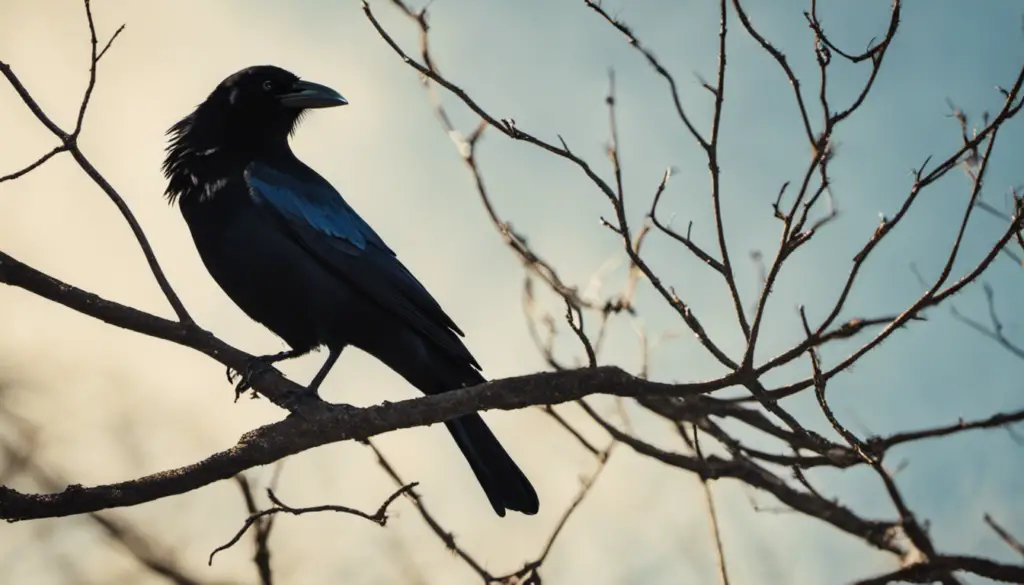
The cultural significance and mythology associated with these black birds reveal intriguing insights into their symbolic roles in various societies. Grackles have been a prominent figure in Native American folklore, often representing transformation and adaptability. In some tribes, they are believed to possess spiritual powers and are seen as messengers between the physical and spiritual realms. Their iridescent feathers are considered sacred and are used in ceremonial rituals.
Grackles also hold a significant place in Mexican mythology. In Aztec culture, they were associated with the god Huitzilopochtli, the god of war and the sun. It was believed that grackles were the souls of fallen warriors, guiding them to the afterlife. They were seen as protectors, bringing good fortune and warding off evil spirits.
In modern society, grackles are often seen as a nuisance due to their loud calls and habit of stealing food. However, their intelligence and adaptability have also made them a symbol of resilience and resourcefulness. They remind us to embrace change and find creative solutions to overcome challenges.
Overall, the cultural significance and mythology surrounding grackles highlight their importance in various cultures and their role as symbols of transformation, protection, and resilience.
Tips for Identifying Crows and Grackles in the Field
Distinguishing these intelligent black birds can be a challenging task for birdwatchers in the field. But fear not! With a keen eye and these helpful tips, you’ll soon become a pro at identifying crows and grackles.
- Size: Crows are generally larger than grackles, with a wingspan of about 3 feet compared to the grackle’s 2-foot wingspan. Keep an eye out for their overall size when trying to differentiate between the two.
- Beak Shape: Crows have a sturdy, straight beak, while grackles have a longer, more slender beak that curves downwards. Pay attention to the shape of their beaks as it can provide valuable clues for identification.
- Vocalizations: Listen closely to their calls. Crows have a distinctive cawing sound, while grackles produce a variety of harsh, metallic sounds. Familiarizing yourself with their unique vocalizations can help you differentiate between the two.
By keeping these tips in mind and practicing your observation skills, you’ll soon be able to confidently spot and identify crows and grackles in the field. So grab your binoculars and get ready to become a true black bird expert!
Crow vs Grackle Showdown: Frequently Asked Questions
Are crows and grackles considered to be closely related species?
Yes, crows and grackles are closely related species. They may be like distant cousins, sharing some similarities, but also having their own unique characteristics that set them apart.
How do crows and grackles differ in terms of their migration patterns?
Crows and grackles differ in their migration patterns. Crows usually migrate in large groups, while grackles tend to migrate in smaller flocks. Additionally, crows migrate over longer distances compared to grackles.
Can crows and grackles interbreed and produce hybrid offspring?
Crows and grackles cannot interbreed and produce hybrid offspring because they belong to different genera. Crows belong to the genus Corvus, while grackles belong to the genus Quiscalus.
Do crows and grackles have specific roles in maintaining the ecological balance of their habitats?
Crows and grackles play crucial roles in maintaining the ecological balance of their habitats. They are like the “cleanup crew” of the bird world, devouring insects and small animals that could otherwise disrupt the ecosystem.
Are there any cultural beliefs or superstitions associated with crows and grackles in different societies?
Yes, there are cultural beliefs and superstitions associated with crows and grackles in different societies. They are often seen as symbols of both good and bad omens, and their behavior is thought to predict future events.
Conclusion
So there you have it, now you understand the differences between crows and grackles!
You’ve learned about their physical characteristics, habitat preferences, feeding behavior, vocalizations, migration patterns, ecological role, and cultural significance.
Armed with this knowledge, you’ll be able to easily identify these black birds in the field.
Remember, don’t judge a book by its cover, as these birds may look similar but have distinct qualities.
Happy birdwatching!


